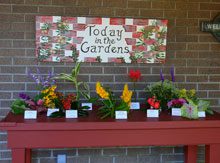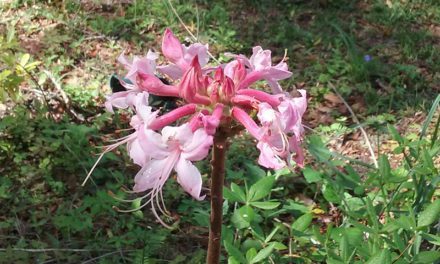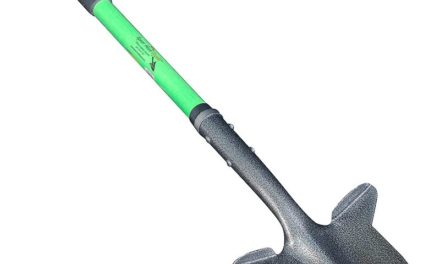 Ahhh, the perfect garden shed – the stuff of dreams. Often,
Ahhh, the perfect garden shed – the stuff of dreams. Often,
we gardeners are relegated to propping the digging fork and
the shovel in a corner of the garage, with the clippers and
shears in a drawer in the kitchen, extra pots and planters
stacked against a wall somewhere, and bags of fertilizer,
potting soil, plus odds and ends in whatever unused shelf or
box we can find.
If we need a potting table, we sometimes make do with the back steps or the picnic table over by the kids’ sandbox. For years I used an old round plastic patio table and employed it whenever I needed to repot loads of plants into bigger containers or plant seeds in flats for the vegetable garden – not perfect, but it served the purpose.
It’s a theme many gardeners live by; whatever is available is what we use, and for most of us
there is no dedicated garden shed. Hardly a surprise, then, that gardeners the world over
sometimes spend time (if not energy and money!) imagining the ideal shed.
The English, who always seem to be at the fore in any discussion about gardening, are particularly happy to retreat to their shed. It is typically regarded as a private space, and, since many English gardeners do their gardening in an allotment, the sacred shed may occupy very precious real estate on that tiny plot.
An allotment is a small section of a large plot of land set aside specially for private gardening spaces leased to individual gardeners. An “official” allotment may be some forty by sixty feet, but sizes vary according to the space available. In the US, we have community gardens with similar plots gardened individually, as well as large gardens tended by members of the community as a whole.
Not every allotment holder lives close to the garden, and many allotments have a small building in the back of the plot. Most of these sheds are what you would expect: rough structures nailed together from whatever materials were available. They provide a space for storage, for garden-centered labors, and for shelter from the elements. They are often, as well, a bolt-hole, an escape, a place just to be alone.
In recent years there has been a movement to carry this humble idea of a garden shed to rather an extreme, with national journals and garden societies sponsoring competitions for the most elegant, the most wacky, the most unique structure, in a search for the Shed of the Year. They can get pretty outrageous.
While we in the Lowcountry may not feel the need for such an exuberant shed, there’s plenty of incentive to have a shed that reflects to some extent the style of the house, or the sense of the garden, or the taste of the gardener. Those mass marketed sheds available from the big-box stores – some made of metal panels, others of plastic, still others of wood – usually lack charm, but they are certainly functional in varying degrees. They can be tarted up relatively easily with the addition of windows, some paint, and a planter box or two.
Instead, consider adapting an already existing structure to use. Here on the farm, we were once “blessed” with now-removed outbuildings, any one of which would have made a perfectly acceptable garden shed if we had had the foresight and the willingness to save them. There was the chicken coop, which provided enough rich soil that a camellia on its site is now nearly sixteen feet tall. There was the smokehouse, which was between two large pecan trees out the back door. There was the old cow barn, with its fenced in paddock full of muck, which eventually found its way in the garden. Even the old hand-dug well, lined with brick up to the wooden well-head structure with its windlass, could have been integrated into a version of the garden shed, but all those structures have collapsed, been taken down and reused, or filled in over the last half century.
We’re left with the hay barn, with its second story loft, the garage/workshop, which also has a second story, and a seriously tottering fertilizer shed, clad in beautifully rusted steel panels over a rotting substructure of three bays. Although any one of the three could make a better-than-usual garden shed, the old fertilizer shed has become the garden-focused work area.
 It shares that role by storing old structural timbers, hand-sawn boards, and odds-and-ends saved from the demise of earlier outbuildings, but there is plenty of room. The shed is some fourteen feet by thirty feet, and its back wall has another ten-by-thirty extension under a tin roof out back.
It shares that role by storing old structural timbers, hand-sawn boards, and odds-and-ends saved from the demise of earlier outbuildings, but there is plenty of room. The shed is some fourteen feet by thirty feet, and its back wall has another ten-by-thirty extension under a tin roof out back.
I need dry, off the ground surfaces for storing some materials, like containers of potting soil that I mix myself; the pine bark fines, mushroom compost, perlite, peat moss, coir fiber, and anything else I might use in a soil-less potting mix also gets stored back there. Acidifying products, such as Holly-tone; soil sweeteners, such as dolomitic lime; and other gardening supplies, such as sulfur, fertilizers, slow-release fertilizer, and any unmentionable, unfashionable, still usable chemicals that occasionally get used in the garden – all these need dry, secure storage, so there are long low shelves/platforms raised on blocks or bricks. This creates marvelous warm dark spaces below, perfect for assorted creatures with zero legs, or four, both warm-blooded and cold. We mostly get along just fine, but there are families of feral cats at all the farms around here that handle the overpopulations. All the more reason to be very selective about which chemicals are used here and with how well-secured they are kept.
I also need a large flat space at counter height. Actually, I have found that two different heights work better – one large counter at about 38 inches, and one about 32 inches. This allows me to work with pots large and small, and make shifting contents from one container to another a little easier.
There’s a broad flat space of bare ground that holds years’ accumulation of pots and containers. Some are terra cotta, a few are the very good and insanely expensive terra cotta, a great many are the black plastic nursery containers we all know and love. There are giant thirty-inch wide containers, and there are little seed-starter pots. It’s nice to have them sorted, clean, and available when needed.
There’s a chair, for when I need to take a moment to gather my wits, and a little table on which to place safely an encouraging beverage. There is not (but there absolutely should be) provision for running water. The three sides of the structure (one side is completely open beneath wide overhanging eaves) offer lots of wood structural members on which to hang supports for garden implements and tools. There are tight-lidded plastic storage bins for assorted items. The compost bins are nearby, seething with earthworms and ridding us of household garbage. And, finally, there is a huge trashcan, also lidded, to dispose of the inevitable accumulation of wrappings, boxes, tape, staples, packaging that seems to overwhelm any time I buy something from the store.
It’s a mess. But, you know, I have a picture in my mind of what I can do to make it perfect!







